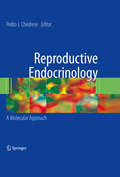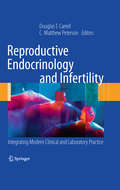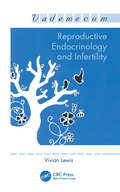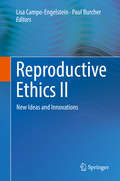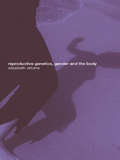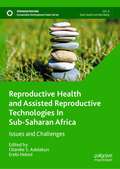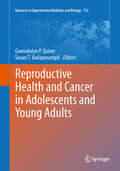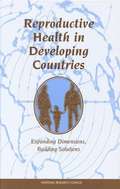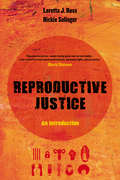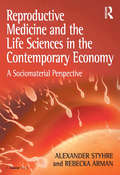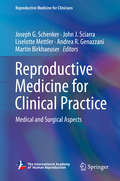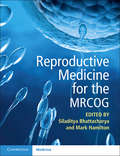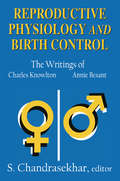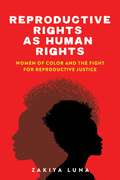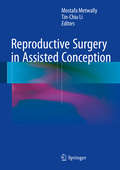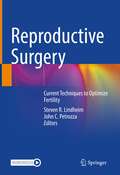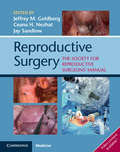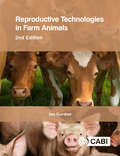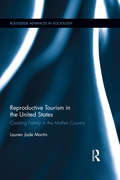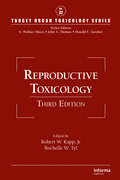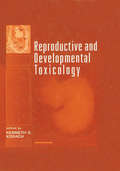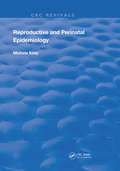- Table View
- List View
Reproductive Endocrinology
by P. Jorge ChedreseMolecular biology emerged from advances in biochemistry during the 1940s and 1950s, when the structure of the nucleic acids and proteins were elucidated. Beginning in the 1970s, with nucleic acid enzymology and the discovery of the restriction enzymes, the tools of molecular biology became widely available and applied in cell biology to study how genes are regulated. This new knowledge impacted endocrinology and reproductive biology since it was largely known that the secretion of the internal glands affected the phenotypes, and expression of genes. Modern reproductive biology encompasses every level of biological study from genomics to ecology, encompassing cell biology, biochemistry, endocrinology and general physiology. All of these disciplines require a basic knowledge, both as a tool and as an essential aid to a fundamental understanding of the principles of life in health and disease. Overall, molecular biology is central to scientific studies in all living matter, impacting disciplines such as medicine, related health sciences, veterinary, agriculture and environmental sciences. In this book, the basic biochemistry of nucleic acids and proteins are reviewed. Methodologies used to study signaling and gene regulation in the endocrine/reproductive system are also discussed. Topics include mechanisms of hormone action and several endocrine disorders affecting the reproductive system. Professionals in the medical, veterinary and animal sciences fields will find exciting and stimulating material enhancing the breadth and quality of their research.
Reproductive Endocrinology and Infertility
by Douglas T. Carrell C. Matthew PetersonManagement of the modern reproductive endocrinology and infertility clinic has become very complex. In addition to the medical and scientific aspects, it is crucial that the modern director be aware of of incongruent fields such as marketing, accounting, management, and regulatory issues. Reproductive Endocrinology and Infertility: Integrating Modern Clinical and Laboratory Practice was developed to assist the practicing reproductive endocrinologist and/or laboratory director by providing an overview of relevant scientific, medical, and management issues in a single volume. Experts in all pertinent areas present concise, practical, evidence-based summaries of relevant topics, producing a key resource for physicians and scientists engaged in this exciting field of medicine. As novel technologies continue to amplify, Reproductive Endocrinology and Infertility: Integrating Modern Clinical and Laboratory Practice offers insight into development, and imparts extra confidence to practitioners in handling the many demands presented by their work.
Reproductive Endocrinology and Infertility
by Dr. Vivian LewisReproductive Endocrinology and Infertility provides an overview of the most frequently encountered clinical challenges faced by medical students and residents. Part I begins with chapters on reproductive hormonal physiology and development to provide a basis for understanding the management of the most common reproductive clinical problems that confront obstetrician-gynecologists and other practitioners in women’s health. Several of the chapters, including obesity, premenstrual syndrome, menopause and imaging, provide a cross-disciplinary approach to endocrine related problems common among reproductive aged women. Part II includes chapters on the evaluation of infertility, as well as surgical and medical approaches to treating infertility in men and women. The chapter on alternative medicine provides a basis for understanding the increasingly popular use of therapies such as acupuncture and herbal treatments. The last chapter discusses the influence of environmental factors on fertility, an important field that is often ignored in the traditional approach to infertility.This text is meant to be used as a portable reference with readily accessible information including a summary of key points in each chapter. All of the contributors are involved in residency training programs and understand the kinds of patient management questions that are encountered in a busy practice. Our goal with this book is to provide information that will support solid patient management and hopefully pique the appetite to learn more.
Reproductive Ethics II: New Ideas and Innovations
by Lisa Campo-Engelstein Paul BurcherThis book is the second collection of essays on reproductive ethics from Drs. Campo-Engelstein and Burcher. This volume is unique in that it is both timely and includes several essays on new technologies, while also being a comprehensive review of most of the major questions in the field, from racial disparities in reproductive healthcare to gene editing and the possibility of the creation of a transhuman species. The scholars writing these essays are pre-eminent in their fields, and their backgrounds are quite varied, including philosophers, anthropologists, physicians, and professors of law. Reproductive ethics remains an underdeveloped area of bioethics despite the recent technological breakthroughs that carry both great promise and potential threats. Building on the first volume of work from a conference held just over one year ago, this new collection of essays from a conference held April 2017 continues this discussion as well as provides ethical insights and reviews of these emerging technologies. The ethical questions swirling around human reproduction are both old and new, but the conference presentations, and the essays derived from them, focus on new ways of appreciating old arguments such as the ethics of abortion, as well as new ways of seeing new technologies such as CRISPR and mitochondrial transfer.
Reproductive Genetics
by Sean Kehoe Lyn Chitty Tessa HomfrayThis is a unique book, covering areas not available elsewhere. Within its pages, the authors discuss many diverse areas relating to reproduction and genetics. Great progress has been made in the field of genetics within the past decade. This, combined with our growing knowledge, has impacted on this important area with interesting consequences. The ability to identify genetic defects before implantation, to diagnose fetal abnormalities and to introduce screening programmes means that genetic testing now has a major role in preventive medicine. These topics are discussed in detail in the book. In parallel with these advances, other aspects that cannot be ignored, such as education of the public and the potential ethical dilemmas that may arise by virtue of these new methodologies, are raised and discussed in this volume, which is based on the 57th RCOG Study Group and includes a set of consensus views from the expert participants. This book provides topical and essential information for practising clinicians, researchers and other healthcare professionals interested in these fields of study.
Reproductive Genetics, Gender and the Body
by Elizabeth EttorreThis book is all about reproductive genetics, a sociological concept developed to define the use of DNA-based technologies in the medical management and supervision of reproduction and pregnant women. In a searching analysis, Elizabeth Ettorre uncovers the hidden social processes involved in the development of these technologies. Focussing on prenatal screening, she explores how the key concepts of gender and the body are intertwined with the process of building genetic knowledge and some of the unintended consequences for women. These include the injection of biology into social relationships and the development of a gendered discourse of shame and stigmatisation in which the perfect body becomes idealised and new conceptions of disability are shaped. It becomes clear that the modernist tradition of scientific disinterestedness is being replaced by a new ethic: the making of moral judgements by scientists. Reproductive Genetics, Gender and the Body draws on interviews with European medical, legal and nursing professionals and raises important issues around the gendered, female body, the site of genetic capital. It challenges professional and scholar alike to grapple with and think through their responsibilities in this complex field where the competing issues have yet to be resolved.
Reproductive Health and Assisted Reproductive Technologies In Sub-Saharan Africa: Issues and Challenges (Sustainable Development Goals Series)
by Olanike S. Adelakun Erebi NdoniThis book focuses on reproductive health rights and assisted reproductive technologies (ART) in sub-Saharan Africa. Each chapter is connected to the other by focusing on different aspects of ART as a means of achieving conception.Topics such as regulation of ART practices, surrogacy and specific aspects of ART, which are gradually becoming acceptable but largely unregulated in Africa, promises to be of interest to scholars, researchers and fertility practitioners. Research in the book take a rights based approach and ethical analysis of ART practice in sub-Saharan Africa by authors from diverse backgrounds bringing together law and society perspectives.Readers stand to gain new knowledge on the societal, legal, medical and psychological requirements, effects and challenges of reproductive health rights and ART in the African context. The book is also relevant to UN Sustainable Development Goal 3: Good Health and Well-being, given that it promotes and advocates for access to reproductive healthcare for persons who have difficulty or are unable to conceive without medical assistance.
Reproductive Health and Cancer in Adolescents and Young Adults
by Gwendolyn P Quinn Susan T. VadaparampilReproductive medicine is a growing field with new technology emerging faster than we can assess consumer's perceptions of -the number of cancer survivors are growing and there is a great need to attend to their quality of life-this book addresses the needs of males and females, identifies effective communication strategies and proactive measures for health care professionals and researchers to use as well as identifying gaps in the literature where more research is needed.
Reproductive Health in Developing Countries: Expanding Dimensions, Building Solutions
by Panel on Reproductive HealthSexually transmitted diseases, unintended pregnancies, infertility, and other reproductive problems are a growing concern around the world, especially in developing countries. Reproductive Health in Developing Countries describes the magnitude of these problems and what is known about the effectiveness of interventions in the following areas: Infection-free sex. Immediate priorities for combating sexually transmitted and reproductive tract diseases are identified. Intended pregnancies and births. The panel reports on the state of family planning and ways to provide services. Healthy pregnancy and delivery. The book explores the myths and substantive socio-economic problems that underlie maternal deaths. Healthy sexuality. Such issues as sexual violence and the practice of female genital mutilation are discussed in terms of the cultural contexts in which they occur. Addressing the design and delivery of reproductive health services, this volume presents lessons learned from past programs and offers principles for deciding how to spend limited available funds.Reproductive Health in Developing Countries will be of special interest to policymakers, health care professionals, and researchers working on reproductive issues in the developing world.
Reproductive Justice: An Introduction (Reproductive Justice: A New Vision for the 21st Century #1)
by Rickie Solinger Loretta J. RossReproductive Justice is a first-of-its-kind primer that provides a comprehensive yet succinct description of the field. Written by two legendary scholar-activists, Reproductive Justice introduces students to an intersectional analysis of race, class, and gender politics. Clearly showing how reproductive justice is a political movement of reproductive rights and social justice, the authors illuminate how, for example, a low-income, physically disabled woman living in West Texas with no viable public transportation, healthcare clinic, or living-wage employment opportunities faces a complex web of structural obstacles as she contemplates her sexual and reproductive intentions. Putting the lives and lived experience of women of color at the center of the book and using a human rights analysis, Loretta J. Ross and Rickie Solinger show how the discussion around reproductive justice differs significantly from the pro-choice/anti-abortion debates that have long dominated the headlines and mainstream political conflict. In a period in which women's reproductive lives are imperiled, Reproductive Justice provides an essential guide to understanding and mobilizing around women's human rights in the twenty-first century. Reproductive Justice: A New Vision for the Twenty-First Century publishes works that explore the contours and content of reproductive justice. The series will include primers intended for students and those new to reproductive justice as well as books of original research that will further knowledge and impact society. Learn more at www. ucpress. edu/go/reproductivejustice.
Reproductive Medicine and the Life Sciences in the Contemporary Economy: A Sociomaterial Perspective
by Alexander StyhreIn Reproductive Medicine and the Life Sciences in the Contemporary Economy, Alexander Styhre and Rebecka Arman illuminate issues that have given rise to terms such as 'the bioeconomy' and 'the baby business'. The life sciences play an increasing role in providing services and commodities consumed by businesses and the public. Based on an in-depth study of clinics offering assisted fertilization in Sweden, this book is the first to examine the commercialization and commodification of know-how derived from the life sciences, from the point of view of organization theory. In the field of reproductive medicine there has been significant growth of both public and private clinical work. Clinics are places where individual interests and concerns and social and institutional arrangements intersect. With a front office where patients encounter various professional groups and a back office comprising the laboratories wherein human reproductive materials are handled and stored, they are more than just places in which medicine is applied in a clinical setting. Clinicians in this field actively influence policy-making and the regulatory frameworks that monitor and set the boundaries for their work. These are places where social and cultural interests and concerns are translated into policies and practice. The clinics are open social systems, responding to and influencing discussions. This book combines organization theory, sociological theory, gender theory, science and technology studies, and philosophy. It emphasises the critical importance of a sociomaterial perspective on organization, stressing how material and social resources are always of necessity folded into each other in day-to-day organizing.
Reproductive Medicine for Clinical Practice: Medical And Surgical Aspects (Reproductive Medicine For Clinicians Ser. #1)
by Andrea R. Genazzani Liselotte Mettler Martin Birkhaeuser Joseph G. Schenker John J. SciarraThis first volume of the series of the International Academy of Human Reproduction focuses on new aspects of reproductive medicine, from the professional responsibility model of ethics to the areas of high clinical involvement in human reproduction, such as endometriosis, polycystic ovary, family planning and post-coital contraception. The book discusses fertility and assisted reproductive techniques in the context of genetics and epigenetics as well as psychosomatic and longevity aspects. In addition, it presents new technologies and therapeutic strategies to improve IVF results and prevent ovarian hyperstimulation syndrome, as well the new challenges and the future of imaging in reproduction. Menopause and the effects of estrogens on atero-prevention, mood, and more generally the reproductive hormones impact on dementia and healthy aging are also covered. Further, it includes a section devoted to innovative aspects of gynecological surgery, discussing the treatments of vaginal aplasia, reproductive microsurgery and technological breakthroughs in pelvic organ prolapse surgery. Last, but not least, it examines the syndromic aspects of preterm birth. This volume is a useful and comprehensive tool for gynecologists, obstetricians, endocrinologists and all specialists who deal with women’s reproductive health.
Reproductive Medicine for the MRCOG
by Siladitya Bhattacharya Mark HamiltonAn authoritative account of the causes of infertility that fully explores the clinical assessment of patients and covers the decision-making behind treatment options. The content follows the MRCOG syllabus as well as delving deeper into subjects covered by the RCOG Advanced Training Skills Modules (ATSMs), leaving readers well prepared for their examinations. Written by nationally recognised leaders in the field, this volume concisely reviews contemporary clinical practice. Using an aetiology-based approach, chapters discuss ovulatory dysfunction, endometriosis, male infertility, uterine/tubal factors and unexplained infertility. The increasing use of third-party reproduction and surrogacy is explored, along with the psychosocial aspects of this type of treatment. Ethical dilemmas surrounding reproductive medicine and their management are covered in depth. With an emphasis on practical approaches to the delivery and organisation of clinical and laboratory services, readers learn how to ensure the support and care they offer is of the highest quality.
Reproductive Physiology and Birth Control: The Writings of Charles Knowlton and Annie Besant
by S. Chandrasekhar"I say that this is a dirty, filthy book, and the test of it is that no human being would allow that book on his table, no decently educated English husband would allow even his wife to have ità." Such was the uncompromising pronouncement of Sir Hardinge Gifford, Her Majesty's Solicitor General, who in 1877 prosecuted Charles Bradlaugh and Annie Besant for publishing Dr. Charles Knowlton's Fruits of Philosophy.Knowlton's work was the first American medical handbook on contraception. It had become an incredibly popular book among Britons who believed the neo-Malthusian dictum that the only solution to poverty in Britain was a limit on the growth of its population. They saw effective birth control measures as a way to make such a limit practicable. In 1877, its publisher was hauled into court and pleaded guilty to printing obscene material. Bradlaugh and Besant tested the right of official harassment by bringing out an edition of the Fruits of Philosophy that bore an introduction explaining their motives. The pair was arrested and charged with violating the Obscene Publications Act of 1857.Their arrest, trial, conviction, and eventual acquittal constitute a landmark in the history of the world birth control movement. The enormous publicity accorded the principals and their cause brought the subject of family planning into the homes of nearly every Briton who read the newspapers' sensational coverage. What followed thereafter is telling: a dramatic, steady decline in the English birthrate. By their simple act of publishing Knowlton's short book, Bradlaugh and Besant helped establish England's pioneering role in the dissemination, democratization, and implementation of birth control information.Sripati Chandrasekhar is an internationally respected demographer and social scientist. He is a former minister of health and family planning in India and was vice-chancellor of Annamalai University in South India. He is the author of numerous books and articles on population and family planning.
Reproductive Rights as Human Rights: Women of Color and the Fight for Reproductive Justice
by Zakiya LunaReveals both the promise and the pitfalls associated with a human rights approach to the women of color-focused reproductive rights activism of SisterSongHow did reproductive justice—defined as the right to have children, to not have children, and to parent—become recognized as a human rights issue? In Reproductive Rights as Human Rights, Zakiya Luna highlights the often-forgotten activism of women of color who are largely responsible for creating what we now know as the modern-day reproductive justice movement.Focusing on SisterSong, an intersectional reproductive justice organization, Luna shows how, and why, women of color mobilized around reproductive rights in the domestic arena. She examines their key role in re-framing reproductive rights as human rights, raising this set of issues as a priority in the United States, a country hostile to the concept of human rights at home.An indispensable read, Reproductive Rights as Human Rights provides a much-needed intersectional perspective on the modern-day reproductive justice movement.
Reproductive Surgery in Assisted Conception
by Mostafa Metwally Tin-Chiu LiTo many patients and indeed health care professionals, IVF is the ultimate treatment for infertility. However in many cases IVF is not feasible and may not be indicated. IVF remains a largely inefficient procedure that often does not succeed in a achieving a pregnancy. There remains a strong place for other fertility interventions, many of them surgical in nature. Surgical interventions can be used as a stand-alone fertility treatment or as an adjuvant treatment used in conjunction with other assisted conception treatments. Despite the continuing use of such techniques by reproductive surgeons, there remains a clear gap in the literature regarding resources to supplement formal training in the field or to provide a reference for established and aspiring practitioners.
Reproductive Surgery: Current Techniques to Optimize Fertility
by Steven R. Lindheim John C. PetrozzaThis well-illustrated, user-friendly text offers a succinct overview of complex surgical sparing management of reproductive pelvic disorders, designed for the reproductive endocrinology and infertility specialist and general gynecologist. World-renowned experts in these areas have contributed detailed chapters that will bolster the surgical knowledge of challenging clinical reproductive infertility scenarios requiring laparoscopic and hysteroscopic skills to enhance fertility outcomes.Providing an understanding of when minimally invasive reproductive surgery is indicated, this book presents clinical pearls to help manage specific pathologies and strategies for managing and minimizing the risks of complications in operative laparoscopy and hysteroscopy. It does so by reviewing pelvic and retroperitoneal anatomy and how it applies to myomectomy, extensive endometriosis, ovarian-tubal surgery, septum, C/S scar isthmocele, Mullerian uterine and vaginal anomalies, and managing complications including bladder and bowel injury. Additionally, selected chapters include accompanying video segments for real-world demonstration of techniques.Reproductive endocrine infertility specialists, as well as clinicians of obstetrics and gynecology interested in reproductive endocrinology and infertility, will find Reproductive Surgery a valuable and focused resource.
Reproductive Surgery: The Society for Reproductive Surgeons' Manual
by Ceana H. Nezhat Jeffrey M. Goldberg Jay Ira SandlowGain confidence in the surgical management of female and male infertility. Authored by leading experts in operative gynecology and urology, in collaboration with the Society of Reproductive Surgeons, this valuable handbook provides readers with a comprehensive understanding of the indications, techniques, and outcomes of modern reproductive surgery. This manual presents clear step-by-step instructions illustrated with intraoperative photographs and surgical videos in order to offer patients surgical options and avoid, or improve, IVF.
Reproductive Technologies in Farm Animals
by Ian GordonBuilding on the successful structure of the first edition, the second edition of Reproductive Technologies in Farm Animals has been totally updated and revised to provide an up to date account of the key techniques employed in manipulating reproduction in farm animals, including beef and dairy cattle, pigs, sheep, goats, buffaloes, camelids, horses and poultry. A classic introductory text to the subject, the book is based on a comprehensive review of the current literature. It: - outlines different agricultural systems and explores the ethical implications of modern farming methods; - details the many new developments, including the commercial application of sexed semen and large-scale application of in vitro produced cattle embryos; - provides a valuable synopsis of current and future reproductive technologies, such as cloning and the production of transgenic animals. This text remains key reading for students in animal science, agriculture, veterinary medicine and biology, and veterinary practitioners and farmers who wish to keep updated on developments in techniques that may be useful in their daily practice.
Reproductive Technologies in Farm Animals
by Ian GordonBuilding on the successful structure of the first edition, the second edition of Reproductive Technologies in Farm Animals has been totally updated and revised to provide an up to date account of the key techniques employed in manipulating reproduction in farm animals, including beef and dairy cattle, pigs, sheep, goats, buffaloes, camelids, horses and poultry. A classic introductory text to the subject, the book is based on a comprehensive review of the current literature. It: - outlines different agricultural systems and explores the ethical implications of modern farming methods; - details the many new developments, including the commercial application of sexed semen and large-scale application of in vitro produced cattle embryos; - provides a valuable synopsis of current and future reproductive technologies, such as cloning and the production of transgenic animals. This text remains key reading for students in animal science, agriculture, veterinary medicine and biology, and veterinary practitioners and farmers who wish to keep updated on developments in techniques that may be useful in their daily practice.
Reproductive Tourism in the United States: Creating Family in the Mother Country (Routledge Advances in Sociology #142)
by Lauren Jade MartinThis book examines the United States as a destination for international consumers of assisted fertility services, including egg donation, surrogacy, and sex selection. Based on interviews conducted with fertility industry insiders who market their services to an international clientele in three of the largest American hubs of the global fertility marketplace - New York City, Los Angeles, and San Francisco - and focusing on the providers rather than the consumers of assisted fertility services, the book shines a light on how professional ethics and norms, in addition to personal moralities, shape the practice of reproductive tourism.
Reproductive Toxicology
by Robert W. Kapp Rochelle W. TylThoroughly examining the popular and expanding field of reproductive toxicology, this newly revised and expanded third edition provides the latest, cutting-edge scientific developments in this constantly evolving discipline. Reproductive Toxicology's contributors are experienced regulatory agency and Clinical Research Organization representatives w
Reproductive ageing
by Susan Bewley William Ledger Dimitrios NikolaouReproductive ageing affects both individuals and wider society, and obstetricians and gynaecologists are witness to the impact of reproductive ageing and to some of the fears and misapprehensions of the general public. This book raises awareness of societal trends and their implications. The wider importance of the subject to the whole of society is emphasized by contributions from outside the world of obstetrics and gynaecology, both within and outside medicine. The 56th RCOG Study Group brought together a range of experts to examine reproductive ageing. This book presents the findings of the Study Group, with sections covering: - background to ageing and demographics - basic science of reproductive ageing - pregnancy: the ageing mother and medical needs - the outcomes: children and mothers - future fertility insurance: screening, cryopreservation or egg donors? - sex beyond and after fertility - fertility treatment: science and reality - the NHS and the market - the future: dreams and waking up.
Reproductive and Developmental Toxicology
by Kenneth S KorachThis timely resource offers extensive discussions on the pharmacological, environmental,endocrinological, and natural factors that alter reproductive or developmental processes-elucidating the effects of toxicants on mechanisms of reproduction. Describing biological actions common to both genders as well as gender-specific processes, Reproducti
Reproductive and Perinatal Epidemiology (Routledge Revivals)
by Michele KielyFirst Published in 1990, Reproductive and Perinatal Epidemiology reviews topics that are central to reproductive and perinatal epidemiology, as well as the methodological issues surrounding research in maternal and child health. Important topics covered include prenatal care, Sudden Infant Death Syndrome (SIDS), epidemiology of neonatal brain hemorrhage, early pregnancy, methodological issues in drug epidemiology, environmental exposures and reproduction, and occupational exposures and reproduction. This book is essential reading for clinicians, researchers, obstetricians, pediatricians, and graduate students in public health.
